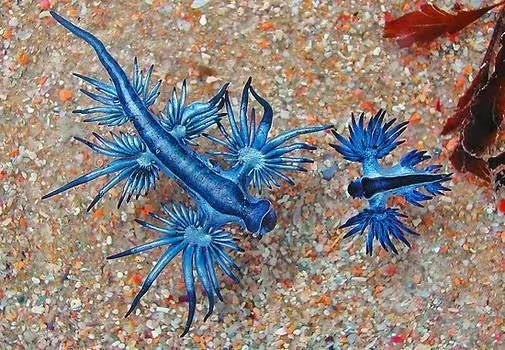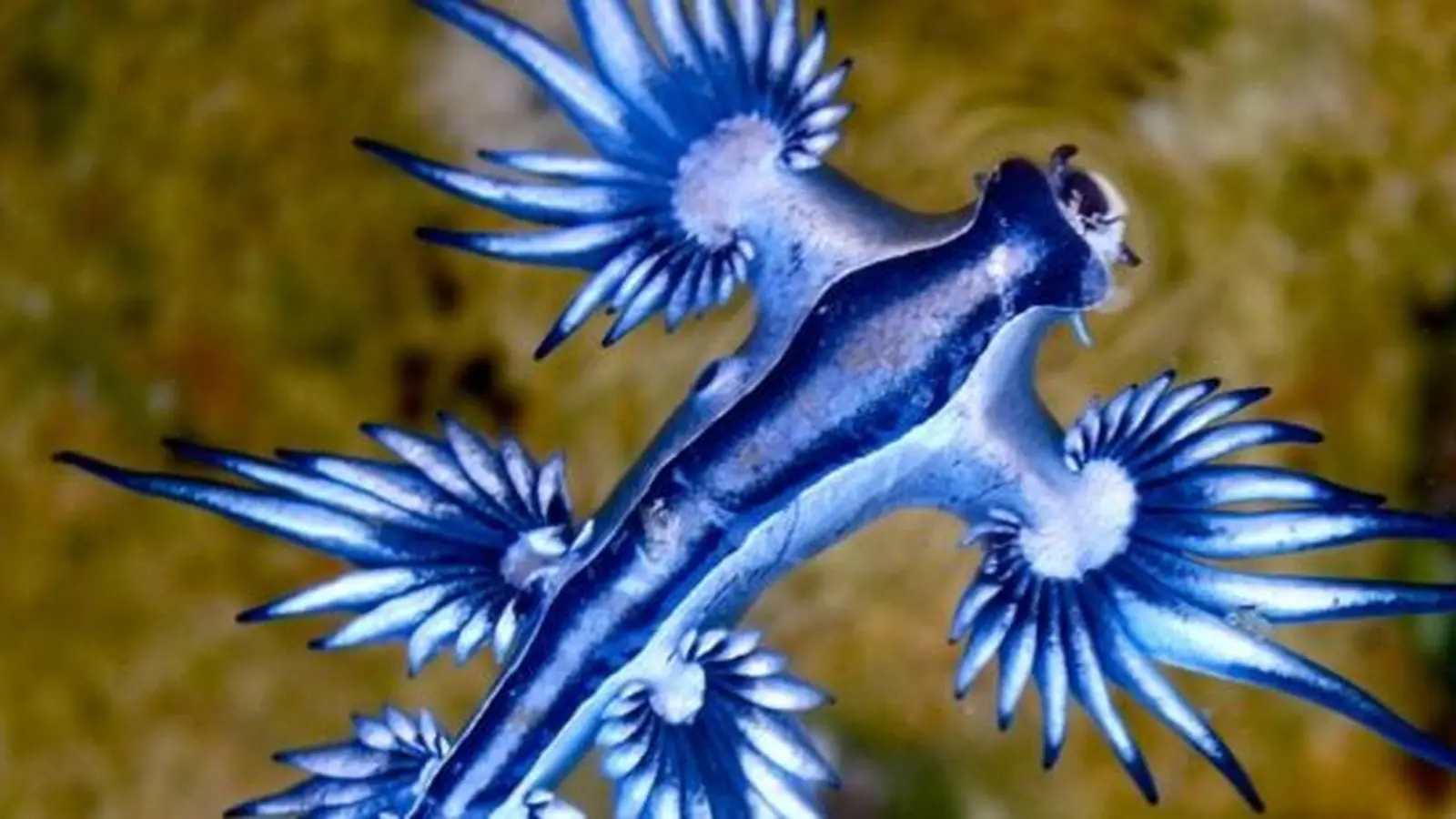8 Minutes
Mediterranean Visitors: When Beauty Requires Caution
Last week a striking aggregation of small, electric-blue nudibranchs forced authorities to close several beaches on Spain's southeastern coast. The animals, commonly called blue sea dragons or blue angels, are Glaucus atlanticus, pelagic nudibranchs best known for their vivid dorsal coloration and unusual life at the ocean surface. Their presence in Guardamar del Segura and nearby beaches captured public attention and prompted immediate safety measures.
Blue sea dragon. (Sylke Rohrlach/Wikimedia Commons/CC BY-SA 3.0)
From above, Glaucus atlanticus appears silver-grey, a camouflage that blends with sea foam and the water surface. From below, however, its underside flashes brilliant azure and indigo. Adults are small — roughly 3 centimeters (about 1.2 inches) long — but their dramatic coloration and unusual ecology make them unmistakable to observers.
Biology and Venom: How a Harmless-Looking Slug Becomes Dangerous
Despite their delicate appearance, blue sea dragons are capable of delivering painful stings. They are not venomous in the conventional sense — rather, they sequester intact stinging cells, called nematocysts, from their cnidarian prey. Glaucus atlanticus feeds on pelagic colonial cnidarians such as the Portuguese man o' war (Physalia physalis) and Velella velella, ingesting the prey's nematocysts and concentrating them within the tips of specialized cerata, the finger-like appendages along their bodies.
Kleptocnidae: stealing stinging cells
This process, often called kleptocnidae (analogous to kleptoplasty in some sacoglossan sea slugs), allows the nudibranch to reuse the prey's defense against would-be predators. When a human or other animal touches the cerata, the retained nematocysts can discharge, causing a reaction similar to being stung by a Portuguese man o' war. Reported symptoms include localized redness, inflammation and pain; more severe responses can include nausea, vomiting and allergic reactions in sensitized individuals.
Local Incident: Guardamar del Segura and Public Response
Local authorities in Guardamar del Segura, a coastal municipality in the Valencian Community, raised a red flag and temporarily banned swimming after multiple sightings and strandings of blue sea dragons along the shoreline. Mayor José Luis Sáez reported via social media that the animals were washing ashore with increasing frequency and number, prompting concerns for unknowing beachgoers.
Local police and municipal services issued advisories urging people not to touch the animals, even if they appear dead. Although many nudibranch carcasses may look harmless, nematocysts retained in the tissue can still fire and cause painful skin reactions. Lifeguards and municipal staff posted warnings and cleared affected stretches of sand until the flotilla dispersed.

Distribution, Migration and Why They Appeared in Spain
Glaucus atlanticus is a cosmopolitan, surface-dwelling species found in temperate and tropical regions worldwide, often associated with floating communities of the open ocean. Normally, large numbers of blue sea dragons are most common in warmer, subtropical waters. Their appearance along the Spanish Mediterranean coast is noteworthy because of regional rarity and because surface temperatures in the western Mediterranean are usually cooler than the species prefers.
Oceanographic drivers
Several oceanographic mechanisms can transport pelagic nudibranchs toward continental shores: wind-driven surface currents, persistent storm systems, seasonal shifts in gyres, and wash-up events associated with blooms of prey species like Velella or Physalia. Astringent weather, onshore winds, or a surge in the local population of floating cnidarians can all contribute to mass strandings.
Climate Context: Is Warming Water a Factor?
Scientists are increasingly attentive to how warming oceans and changing wind patterns can alter the distribution of marine organisms. Because Glaucus atlanticus is limited by temperature — thriving in warm surface waters — a trend of higher sea-surface temperatures could expand its seasonal range northward or prolong periods of presence in marginal seas like the Mediterranean.
However, a direct causal link between climate change and any single wash-up event is difficult to establish. Short-term meteorological conditions and prey availability typically control stranding dynamics. That said, long-term shifts in sea temperature, ocean currents and the abundance of floating cnidarians could change encounter rates between humans and venom-equipped pelagic fauna, increasing the frequency of events that require public-health responses.
Human Health, Safety and Outreach
Public-health guidance after sightings focuses on clear, low-cost measures: raise visible warnings, close swimming where necessary, instruct beachgoers not to touch stranded or floating organisms, and provide first-aid guidance for stings. In the case of nematocyst exposure from Portuguese man o' war or from nematocyst-bearing nudibranchs, recommended steps often include rinsing the area with seawater (not fresh water, which can trigger more nematocyst discharge), removing tentacle fragments with a gloved hand or a flat object, and seeking medical attention for severe or systemic symptoms.
Local authorities legally justified the temporary bans by the potential for painful stings and possible allergic reactions among the public. Municipal warnings also emphasized the ecological importance of the animals, discouraging their removal except by trained personnel and requesting reports from citizens to help track the event.
Expert Insight
Dr. Elena Márquez, Marine Ecologist, University of Alicante: 'Mass strandings of pelagic species like Glaucus atlanticus are an important reminder of how interlinked marine ecosystems are with human safety. These nudibranchs are not seeking out people, but they use the same surface habitats that people recreate in. For managers, the priority is clear signage and public education. For scientists, this is an opportunity to gather data on distributional shifts — simple citizen-science reports can be invaluable.'
Dr. Márquez recommends that municipal authorities coordinate with regional marine institutes to log sightings, sample environmental conditions such as surface temperature and wind direction at the time of the event, and map the presence of associated species such as Velella and Physalia. Over time, this dataset can help disentangle episodic transport events from longer term biogeographic changes tied to climate.
Ecological Significance and Research Opportunities
Beyond the immediate public-safety angle, large numbers of Glaucus atlanticus washing ashore raise questions about prey dynamics, ecosystem connectivity and pelagic food-web interactions. Because these nudibranchs rely on floating cnidarians for both food and defense, changes in the abundance of those cnidarians will cascade to influence nudibranch populations. The observation of a 'blue fleet' could indicate a local bloom of Velella or Physalia, either from upwelling conditions, a regional transport event, or anthropogenic influences on plankton communities.
Researchers can use opportunistic strandings to collect specimens for morphological and genetic study, to test nematocyst sequestration efficiency, and to monitor potential shifts in range. Standardized reporting protocols, photographic records, and environmental metadata (sea-surface temperature, salinity, wind, and current conditions) will improve the scientific value of each observation.
Management and Future Prospects
As coastal populations and recreational use of marine environments grow, managers will face increasing need to balance public access with safety and conservation. Early-warning systems based on satellite-tracked surface winds, citizen reports via dedicated apps, and rapid response signage can reduce risk while minimizing unnecessary closures. Education campaigns — short explanatory panels, social-media posts, and lifeguard briefings — can help beach-goers recognize hazardous species and respond safely.
From a conservation perspective, Glaucus atlanticus is an emblem of pelagic biodiversity. Continued documentation of unusual occurrences will aid efforts to understand how warming seas, changing current patterns and human activity reshape the distribution of surface-dwelling marine fauna.
Conclusion
The recent wash-up of blue sea dragons on Spanish Mediterranean beaches combined a visually arresting natural spectacle with genuine public-safety concerns. These tiny nudibranchs, Glaucus atlanticus, illustrate how ecological interactions — predation on stinging cnidarians and kleptocnidae-based defenses — produce unexpected hazards for humans. While short-term meteorological events likely explain the immediate strandings, researchers are watching for broader patterns that could implicate ocean-warming and altered circulation. In the meantime, local authorities and scientists agree on practical steps: warn the public, avoid contact with stranded animals, collect standardized observations, and study the events to refine future responses. The event underscores a broader truth: rare and beautiful marine life can have surprising consequences when environmental and human systems intersect.
Source: sciencealert


Leave a Comment